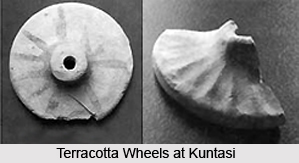 Kuntasi is an important archaeological site and is a portion of the ancient Indus Valley Civilization, famous as the `Bibi-no-Timbo`, located about 30 kms away from Morbi, Maliya Taluka in Rajkot District, Gujarat. The site exists at a distance of nearly 3 kms away from Kuntasi village, on the right bank of Phulki River, based about 5 kms inwards from the current shoreline. Initially, P.P. Pandya discovered this ancient site and it was later explored extensively by Y. M. Chitalwala, excavations conducted by whom has unearthed objects suggesting this region was occupied during two distinct periods. Period I is attributed to the Mature Harappan age which dates back to 2200 to 1900 BCE and the Period II which comprises the Late Harappan phase dating to 1900 till 1700 BCE. The region was declared as a manufacturing centre and also a jetty. Two hectares of unwalled suburbs and walled town are a portion of the Kuntasi town. The western part of the wall contains a stone platform and had been an intricately planned settlement which was employed for shifting of goods, storage and also production.
Kuntasi is an important archaeological site and is a portion of the ancient Indus Valley Civilization, famous as the `Bibi-no-Timbo`, located about 30 kms away from Morbi, Maliya Taluka in Rajkot District, Gujarat. The site exists at a distance of nearly 3 kms away from Kuntasi village, on the right bank of Phulki River, based about 5 kms inwards from the current shoreline. Initially, P.P. Pandya discovered this ancient site and it was later explored extensively by Y. M. Chitalwala, excavations conducted by whom has unearthed objects suggesting this region was occupied during two distinct periods. Period I is attributed to the Mature Harappan age which dates back to 2200 to 1900 BCE and the Period II which comprises the Late Harappan phase dating to 1900 till 1700 BCE. The region was declared as a manufacturing centre and also a jetty. Two hectares of unwalled suburbs and walled town are a portion of the Kuntasi town. The western part of the wall contains a stone platform and had been an intricately planned settlement which was employed for shifting of goods, storage and also production.
Architecture of Kuntasi
Several storage units and a large industrial complex were existent adjacent to the stone platform on the western part of the wall. A house has been uncovered at the middle, which possesses numerable chambers and also a private kitchen. Gigantic, rectangular residential homes were present in the western and northern part of the walled region which was constructed over stone platforms, along with walls composed of mud bricks, following the Harappan style of architecture.
However the houses were bigger as compared to their counterparts in the Harappan civilization. A large kitchen has been discovered in the south-western corner of the settlement which was utilized for the entire settlement. The homes were organised in a great, open space but were devoid of `citadels` unlike those in larger towns which included Banawali, Kalibangan, Dholavira and other cities of the Indus Valley Civilization.
Erected with the aide of mud and boulders, Kuntasi was equipped with double walls and was separated by a passage measuring nearly 20 metres in width. Kuntasi town possessed a tower at its south-western corner while there was a gate in its eastern end surrounded by guard chambers, probably to regulate public access to the main walled portion.
Artefacts Discovered at Kuntasi
Pottery-wares decorated with drawings and two cylindrical stone anchors are amongst the major discoveries at the town of Kuntasi. The anchors reveal that there might have been certain amount of marine activities at Kuntasi. The archaeological region of Kuntasi is a bit similar to Lothal which is yet another site of the Indus Valley Civilization. The precious `Lapis Lazuli` has been found in a considerable quantity in the ancient Kuntasi town, which suggests that it was probably exported to Mesopotamia from this very spot. Discoveries and excavations have also indicated towards the existence of a sea-route via Rangpur, to Lothal.



















